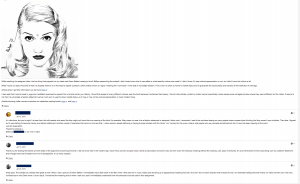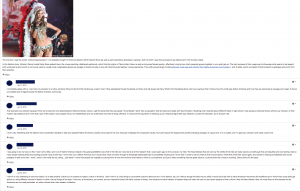Description
Researchers agree that students retain more when active, student-centered learning techniques are employed and that fun and engaging learning experiences foster higher information retention (Bonwell and Eison 1991). When teaching large classes online, this can be difficult, but faculty still want to create an environment that is personal and interactive (Carbone 1998). Faculty want to get to know their students and they want to provide them with opportunities to get to know them and each other (Phillips 2008). So how can faculty foster increased student interaction and engagement with the material, with the faculty member, and with other students? This entry discusses one way to facilitate student-to-content, student-to-student, and student-to-faculty interaction using popular culture in large online classes across disciplines (Alvermann, Moon & Hagood, 1999).
Link to example artifact(s)
Example #1
Teacher: Dr. Keri Watson, University of Central Florida
Course: History of Non-Western Art
Dr. Keri Watson from UCF integrated popular culture to energize online discussions in her undergraduate History of Non-Western Art class of 155 students. This assignment asks students to post an image from an advertisement, magazine, movie, or television program that incorporates an example of Non-Western art or culture. Students were asked to identify the source of the image, the culture it was appropriated from, and how it was being used. The students also were asked to post a short reply (50-75 words) to the post of one of their classmates. On average, students replied to at least two other posts, going above and beyond the assignment to create rich discussions and debates. The following two figures represent two students’ discussion threads in the class.

Figure 1: Discussions of Gwen Stefani’s Bindi. Note: The screenshot photo was updated using an image by abatagestudios under the creative common licence.

Figure 2: Discussions of Indian Head Dress.
Although this assignment was used to have students engage critically with issues of cultural appropriation, this assignment could be adapted to other courses. For example, students could be asked to include an image from pop culture that shows physics at work or pop references to wars. The inclusion of images from pop culture made the assignment come alive for students. Figure one demonstrates students’ discussions on Gwen Stefani’s Bindi.
Example #2
Teacher: Dr. Martha Garcia-Stout, Lecturer, University of Central Florida
Course: Introduction to Pharmacology
Introduction to Pharmacology can be considered a “boring” class to students. To engage the students in the “dry” materials, Dr. Garcia-Stout themed this class after the potions class featured in the popular Harry Potter series.
Drexler James (2019) featured this strategy in UCF Today. The following is an excerpt from this article:
“Each time students are introduced to a new classification of drugs, they first meet the Harry Potter character who needs the drug or “potion” to cure them. Garcia-Stout says this helps make pharmacology memorable.
The inclusion of fictional characters in her case studies has proven to be the magic ingredient in student success. Garcia-Stout says students are discussing and engaging more in this online course than any others she has taught.
One student enjoyed making the connections between her favorite characters and the medicines they could benefit from. She says the class offered her a way to connect with the material unlike any class experience she had before.
Even students that were not fans of the Harry Potter series benefited from the strategy. Since only the names of characters are used, the students can still make the diagnosis.
Dr. Garcia-Stout says she is pleased to see students enjoying the curriculum and learning important concepts that will set them up for a successful career in health care.”
Link to scholarly reference(s)
Alvermann, D. E., Moon, J. S., & Hagood, M. C. (1999). Popular culture in the classroom: Teaching and researching critical media literacy. Literacy Studies Series. International Reading Association, 800 Barksdale Road, PO Box 8139, Newark, DE 19714-8139; Web site: http://www.reading.org.
Bonwell, C., & Eison, J. (1991). Active learning: creating excitement in the classroom. AEHE-ERIC Higher Education Report No. 1. Washington, D.C.: Jossey-Bass.
Carbone, E. (1998). Teaching large classes: tools and strategies. Thousand Oaks, CA: Sage Publications.
James, D. (2019). UCF online course uses ‘Harry Potter’ potions theme to teach pharmacology. https://www.ucf.edu/news/ucf-online-course-uses-harry-potter-potions-theme-to-teach-pharmacology/
Phillips, W. O. (2008). A study of instructor persona in the online environment. Doctoral dissertation, University of Central Florida.
Citation
Watson, K. (2016). Use pop culture to energize online activities. In B. Chen & K. Thompson (Eds.), Teaching Online Pedagogical Repository. Orlando, FL: University of Central Florida Center for Distributed Learning. https://topr.online.ucf.edu/use-pop-culture-to-energize-online-activities/.